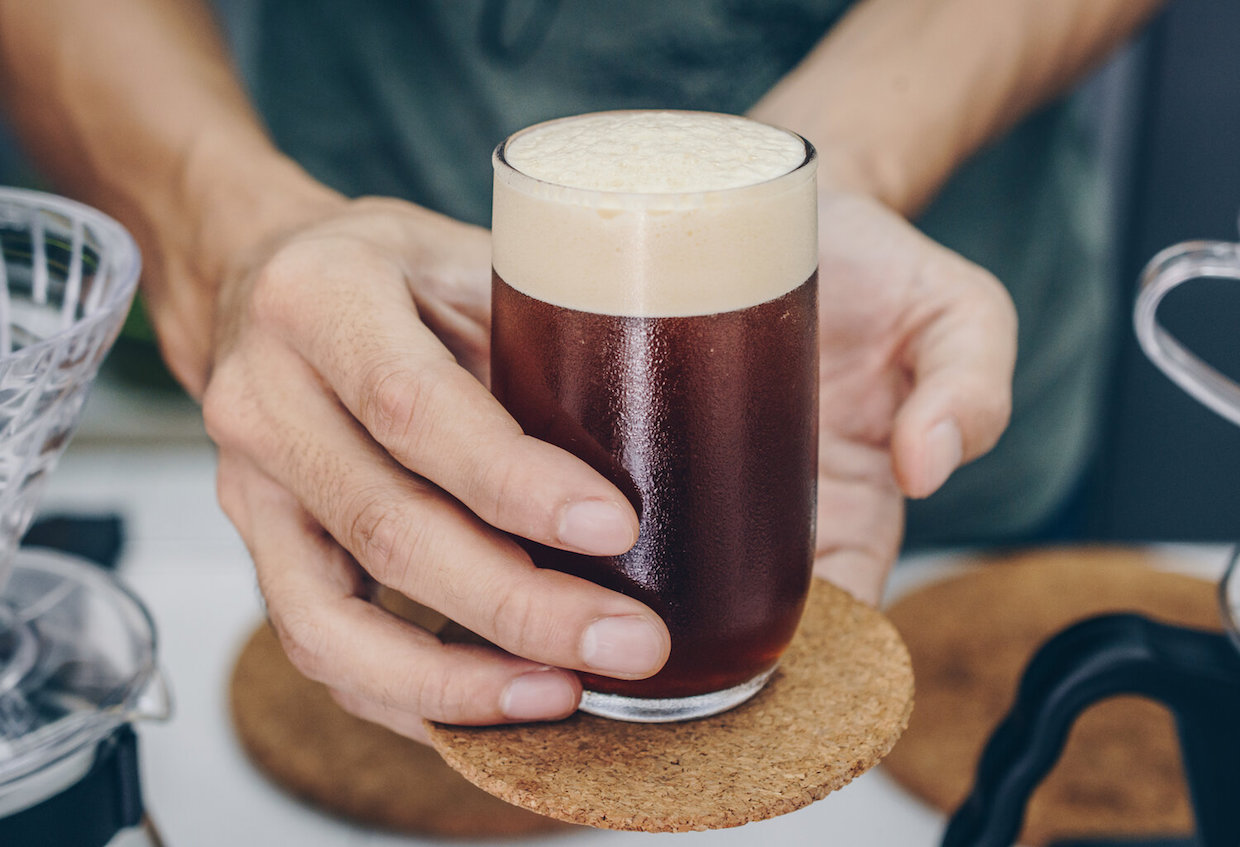by Rich Leeson
What is a Nitro Cold Brew System?
The concept is to take a low-acid, cold-brew-extracted coffee concentrate and mix it with cold water and nitrogen gas. The nitrogen gas is an inert gas that does not change the pH balance of the coffee in a negative way, yet provides creamy texture to the drink. The drink typically layers into three levels, with the center portion moving in a Cascading motion.
The two most common systems of delivery and dispensing are keg systems or bag-in-box (BIB) systems.
How Do These Systems Work?
The keg system works like a beer keg or soda system, where the “ready to drink” Cold Brew coffee is held in either a disposable or reusable keg. A large nitrogen tank and regulator are used to control the Nitrogen gas pressure to push the coffee and nitrogen to the tap handle.
In this system, the coffee in the keg and in the lines of the tap is nitrogenated. The nitrogen inside the keg also acts as a preservation agent to help extend the product life of the coffee or product being dispensed.
The BIB system works more like a concentrate juice dispenser, where the concentrate is pumped into a mixing chamber where cold water and the Nitrogen are introduced to the concentrate, prior to being dispensed into the cup. This type of machine allows for water and concentrate ratios to be easily adjusted to meet the customer’s needs.
Basic Components
With a keg system the key components are:
- The keg with coffee
- A racking or storage system to house the Kegs
- Food-grade nitrogen tanks or a nitrogen generator
- A nitrogen gas pressure regulator
- A keg-dispensing box, like a refrigerator and tap housing
With the BIB system:
- The cold brew concentrates
- Filtered water supply
- A dispenser machine
- A nitrogen tank or generator, or a nitrogen gas module
- A nitrogen Gas Regulator (for tank use)
Top Service Issues and How to Address Them
For both types of systems, it is important for coffee technicians, especially those new to the system, to fully understand the nitrogen delivery process.
Tank systems are large and hold nitrogen gas under high pressure. Safety is key, and there are regulations requiring tanks be chained in such a way so they do not tip over. The Gas regulators must be adjusted to a specific pressure and then locked in that set position. Consideration of how the tanks will get changed when they are empty is a must.
Options to consider are tankless systems, like nitrogen generators, which extract and collect nitrogen from the air around us. The generators can be large and expensive but eliminate the need for tanks. Depending on the manufacturer, nitrogen generators require a preventive maintenance schedule, typically occurring every six months. Tanks and generators provide a similar purity level, between 98%-99.5%.
Another viable option is an air compressor like BUNN’s nitrogen gas module, which cleans the surrounding air before using it as the gas source for nitrogenated beverages. This type of system provides about 78% nitrogen into the drink. These systems reduce the need for tanks, regulators and generators, and are an inexpensive alternative to generators; however, annual service is needed in medium-volume applications. Some are also designed specifically to work with only BIB dispensers, so check with the manufacturer for exact pressure requirements.
Clean, fresh water is needed for the BIB system, so a water filter is a must.
Both types of systems do run a refrigeration compressor for product storage. That equipment generally seems to last, but maintenance may require the tech to be HVAC certified.
The number one service concern will be around the customer-required routine cleanings. The cleanings are critical, and missed cleanings can result in non-operating machines due to clogs and blockages in the dispense tubes, valves and faucet assembly.
The nitro Coffee segment is relatively new, exciting and can be highly profitable. All the product options are not yet known, as we experiment with new ideas and products.
There are many coffees, teas and other beverages waiting to be nitrogenated. As for technical support, we need to learn about these systems and be ready to get in there to keep these machines up and running. While you’re there, take a moment to enjoy a silky nitro coffee.
Editor’s note: Rich Leeson is the Western Zone Technical Manager at BUNN. This article is appearing as part of an unpaid editorial collaboration between DCN and the Coffee Technicians Guild. It was originally published in the CTG blog and is republished here with permission and some edits.
The Coffee Technicians Guild (CTG) is an official trade guild of the Specialty Coffee Association (SCA) dedicated to supporting the coffee industry through the development of professional technicians. Any views or opinions expressed in this piece are those of the author and are not necessarily shared by Daily Coffee News.]
Comment
2 Comments
Comments are closed.







Rich check out nitrobrew…low maintenance and no cartridges needed for for nitrogen infusion
You forgot to mention the brand, NitroBrew. They have systems that can infuse any beverage, and without the need for nitrogen tanks or cartridges. But if you prefer 100% nitrogen you can hook up to that, or any gas for that matter—even c02 for soda.